|
   |
|
Page 6 |
Newsletter 119, Winter 2017 © Hampshire Mills Group |
Country House Tour in Northern Ireland
Angela Smith |
|
In August, Nigel and I
visited Northern Ireland to join a group trip with
the AIA’s Heritage of Industry, visiting Country
Houses with the aim of learning about the technology
rather than the grandiose interiors. What had
caught our eye was the promise of such gems as “saw
mill”, “corn mill”, “gas manufacture”, and other IA-related
subjects. The tour was being led by Prof Marilyn
Palmer, the AIA’s Honorary President, and was
commencing on the afternoon of Monday 7 August with
the last visit on the morning of Friday 11.
Participants had to make their own transport
arrangements to Belfast. We decided to travel on
the Saturday, Flybe from Southampton Airport, to
give us time for independent sightseeing. We were
in the Titanic Quarter by 11:30.
On Sunday we had
planned to visit the Ulster Folk and Transport
Museum at Cultra, a mere 20 minute train ride. The
morning was wet so we spent that in the excellent
Transport Museum before taking the shuttle bus to
the Folk Museum. Like open-air museums such as
Weald & Downland, this is composed of relocated
buildings from all over Northern Ireland and has a
“village” and rural exhibits, three of which are
mills.
Straid Corn Mill:
The site map describes this mill as “currently
closed” – it looked like it had been neglected for
some years. The large wheel and leat were covered
in vegetation so we didn’t bother trying to take any
photos. The mill, consisting of several stone,
slated, single, and 2-storey buildings, comes from
Straid near Ballymena in Co Tyrone. It was part of
a large farm complex which also had two scutch
mills. A mill had been on the site since 1785 but
was rebuilt in 1852. It ceased production after WW2
following a reduction in operation due to
competition from larger mills. It was dismantled
and moved to the museum in the 1980s.
Gorticashel Flax
Mill: Like Straid Mill, this single 2-storey
building has also seen better days, with the wheel
very overgrown. It had been a scutch mill from Co
Tyrone, but the website gives no details of its
history and there is no guide book available. Scutching
is the process of extracting linen fibres from flax
stems by being passed through cogged rollers. It
was a highly dangerous occupation as workers were at
risk from machinery that could not be stopped
quickly, the air was thick with dust, and there was
an ever-present danger of fire. On at least two
occasions this mill had been severely damaged by
fire.
Coalisland Spade
Mill: Although in a good state of repair, this mill
was not manned so we were unable to visit it and the
adjoining building which once housed 4 finishing
shops. The mill, from Derry in Co Tyrone, was built
in the 1850s and moved to the museum in 1960.
|
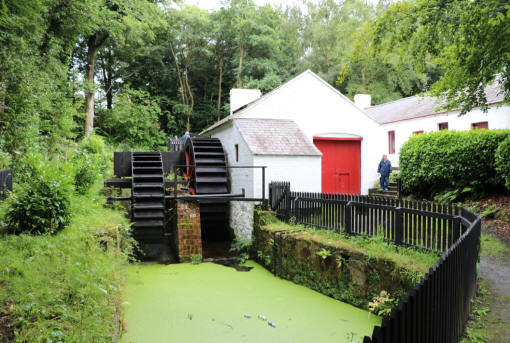 |
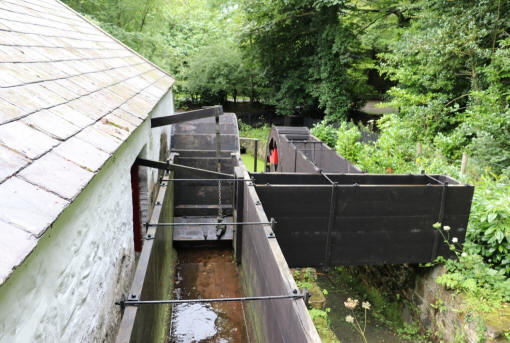 |
|
It is a single storey
building constructed mostly of stone, with the back
gable wall and chimney of brick. A wooden launder –
which was dry – leads from a small dam. There are
two external breast-shot wheels. A massive hammer
in the mill is tripped by a cast iron wheel driven
directly from the larger water wheel. I was able to
take a couple of flash shots through the mill
window. |
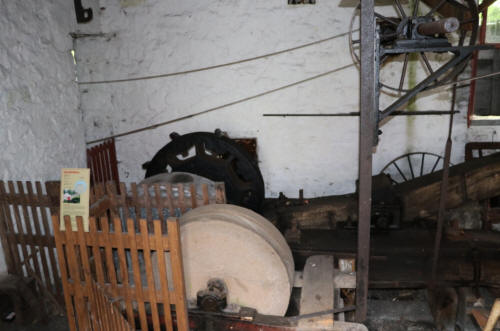 |
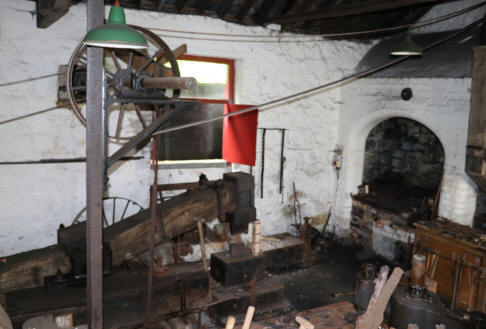 |
|
Between 1800 and 1900
in Ireland, the spade was the most usual tool of
cultivation. Ulster spades had welded sockets and
spade mills were erected to mass-produce them. A
skilled spade maker could make up to 120 varieties
of spade, in up to 5 sizes. This mill was operated
until the 1950s by one family over five generations.
The Tour
On Monday we met up
with the group after lunch. We were led by Bill
Barksfield and Prof Marilyn Palmer and there were 18
other participants. The afternoon’s visit was to
Mount Stewart which only re-opened 3 years ago and
parts are currently still undergoing major
restoration. As I was unable to glean much
information about the mills and so on seen on the
tour, I am grateful to Marilyn for giving permission
to use her tour notes for some mills.
Myra Castle Farm
(south end of Strangford Lough): Tuesday morning
saw us making a private visit to Myra Castle Farm,
owned by David Good who guided us around. The main
house was built about 1844 and the model farm
complex was linked to the house by a meandering
“cut-and-cover” tunnel built for the servants,
top-lit by ships’ portholes, though it was mostly in
darkness. Apart from the water wheel, the site also
has a small lime kiln, weighbridge and almost
complete estate acetylene gas works.
|
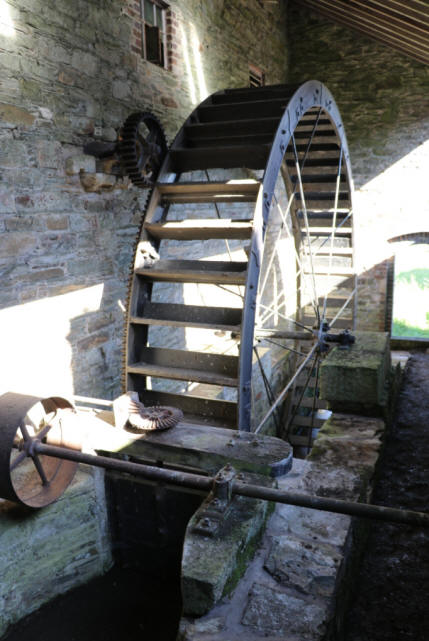 |
The large but narrow
water wheel had been installed to power farm
machinery including a circular saw sited nearby in
an open-sided shed and threshing machinery in the
adjacent barn.
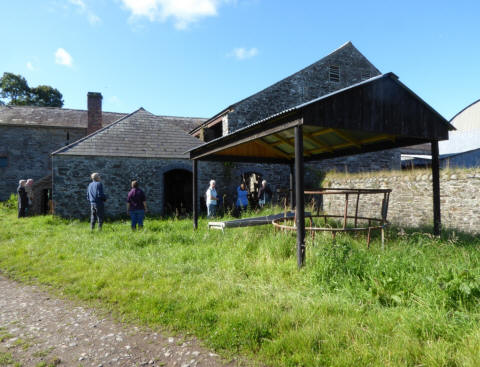 |
|
Water power proved
inadequate because there is also a single cylinder
horizontal steam engine with an upright steam
boiler. Some line shafting survives. Projecting
from the servants’ quarters at the rear of the house
is a circular roofed horse gin which was apparently
built to power a butter churner in the dairy inside
the house. This was built sometime after 1874 but
was disused by 1900. |
 |
|
Castle Ward Estate
Yard (south end of Strangford Lough): After the
farm we then moved on to nearby Castle Ward,
remarkable for the fact that it has two differing
frontages. The 1st Viscount Bangor wanted a
Classical frontage while his wife fancied Gothick.
So both the exteriors and interiors reflect these
tastes. It was built in the 1760s at a cost of
£40,000.
Our very
knowledgeable guide, Martin Gibson, told us that
tide mills are rare in Ireland, although several
were constructed around Strangford Lough during the
1800s. He said that the earliest tide mill was
thought to be at Nedrum, further north on the lough
on a monastic site, dating to around 700AD, and had
a “vertical axis propeller”.
Unlike other mills
seen on this tour, there are a number of useful
descriptive panels with text and diagrams in the
barn adjacent to the mill which I have drawn on for
this section.
|
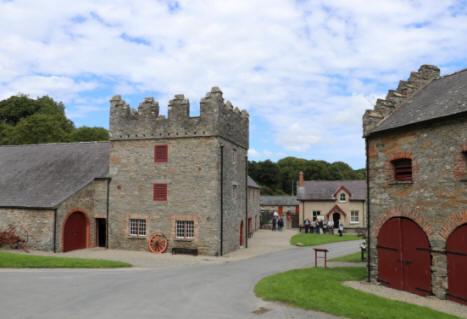 |
The first mill at
Castle Ward was built in the early 1700s and was
used to grind oats, barley and wheat into meal and
flour. It was initially a tide mill operating from
the tidal Strangford Lough which filled a millpond
at the rear at high tide.
A 1744 description
of the operation by Walter Harris says: “On the bay
that opens to the garden is a singular contrivance
for supplying a mill with water. A dead wall is
carried across the gut in which are two arches and
in them two flood gates fixed, the one to admit the
tide, the other to keep it in or let it out, as
occasion serves. By this means a corn-mill is
perpetually supplied with water which can never fail
as long as the tide flows here.”
|
|
Martin explained that
the bottom of the waterwheel was not far above low
water level so, in the 1800s, it was converted to
normal stream operation from the spring-fed large
ornamental lake on the estate, Temple Water, with
channels cut down to the mill.
A corn-drying kiln was
built in 1800. During the 1830s the corn mill was
enlarged and a threshing mill added. New grinding
machinery and a replacement waterwheel were
incorporated, powered exclusively from the Temple
Water without tidal assistance. The machinery was
again renewed in the 1870s but, by the early 1900s,
the mill had ceased operation. It lay dormant,
gradually falling into disrepair, until 1991 when
the National Trust began to restore the mill to full
working order again.
|
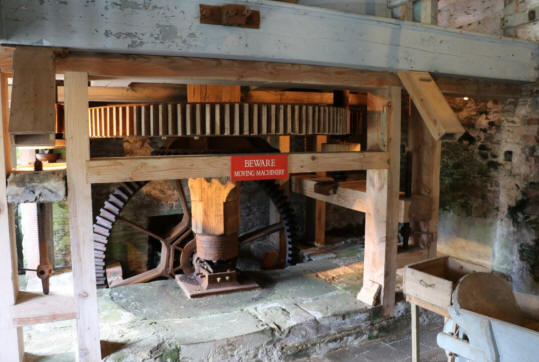 |
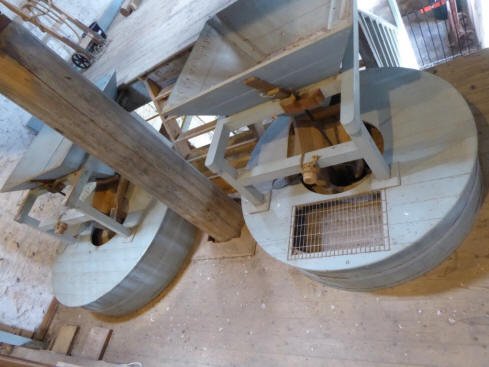 |
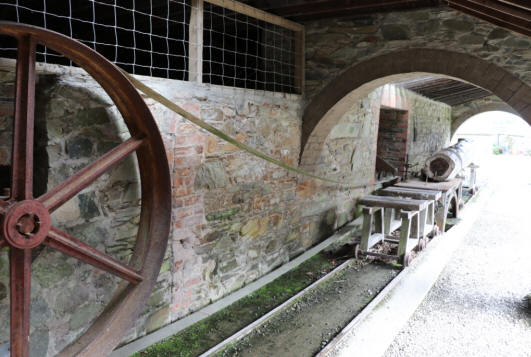 |
The complex houses a
kiln, thresher, winnower and two pairs of
millstones. Remains of the tide mill can still be
seen in the façade. Adjacent to the corn mill is a
sawmill in a barn (left), preserved but not working.
On our tour of the
house I had inspected an old map and spotted a
“Windmill Hill” not far from the estate and asked
Martin about it. He explained to everyone that
there was a line of post mills but, due to being
hand turned, they fell out of use. There is a
preserved smock or tower mill somewhere around the
lough. |
|
Castle Coole (near
Enniskillen): Built between 1789 and 1798 for the
1st Earl Belmore. He commissioned an ice house so
that he could preserve meats and have cool drinks
and ice cream. He built a pump to bring water from
Lough Coole to the new house which is located in a
small octagonal pump house, pumping water to a tank
off the servants’ tunnel from where water was
carried into the house.
|
|
Florence Court: This
‘family home’ was built c1756-64 but suffered a
severe fire in 1955, not long after the National
Trust acquired it. It has now been fully restored.
In the grounds are a sawmill, hydraulic ram and
icehouse. The single storey stone sawmill has a
metal high breast-shot wheel manufactured by William
Maxwell in 1848, and fed by a launder, crossing a
main path, with water from the Larganess River.
The mill was
established in 1840 by the 3rd Earl of Enniskillen
to process timber from the estate. It produced
rough-sawn timber Finished products such as
cartwheels would have been completed in the
carpenter’s shop north of the sawmill.
There is also a
Bark House where bark stripped from the wood was
crushed to extract tannin. The drive for the saw
bench comes from a cog wheel off the pit wheel. The
saw bench was converted to electricity after mains
power arrived about 1951. There is a small electric
motor in a recess in the wall which probably drove a
small free-standing saw bench.
|
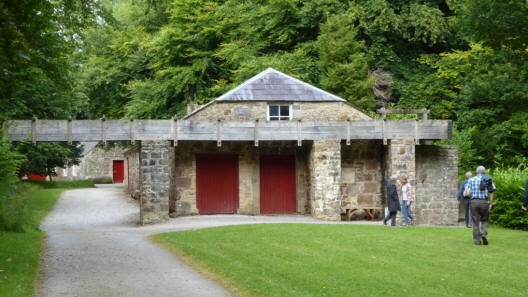
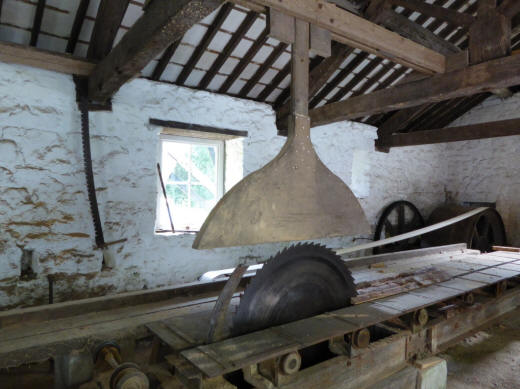
|
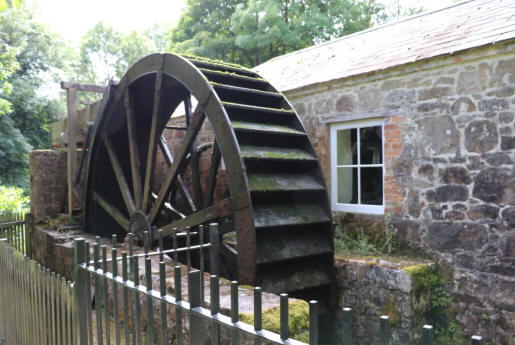 |
 |
|
The Argory: There
were at least three different sources of water for
the house. Outside the east garden pavilion is a
submerged water pump (by W Davis, Navan) presumably
raising water from a well, driven by a horse gin
which is missing its swivelling drive arm. The west
garden pavilion is closer to the river and contains
a manually-cranked water pump, presumably for
pumping up river water. There was also a rainwater
collection tank which may have been the source of
water for a manual pump in the middle of the garden
south-west of the laundry.
|
|
The only feature which
we saw which might be associated with water supply
was what appeared to be a sluice mechanism near the
river with a pipe coming out of it which then
disappears under the grass towards the house. There
was insufficient time to investigate further as we
then had to make our way back to George Best Airport
and the flight home.
All in all, a very
interesting visit to many properties with some mills
thrown in for good measure!
|
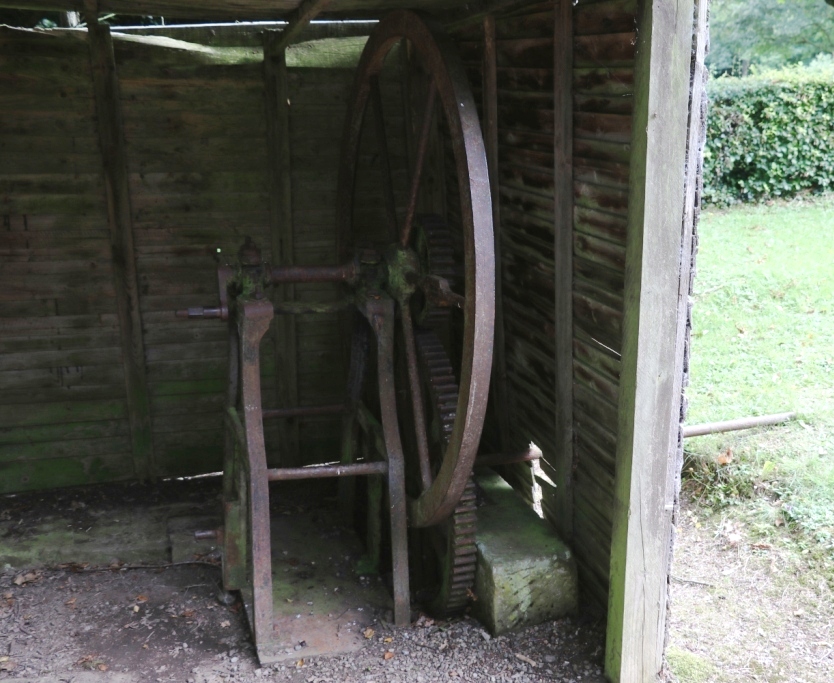 |
| |
| |
| |
| |
|
|
